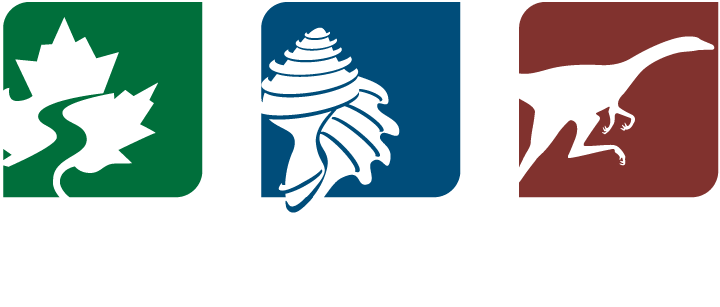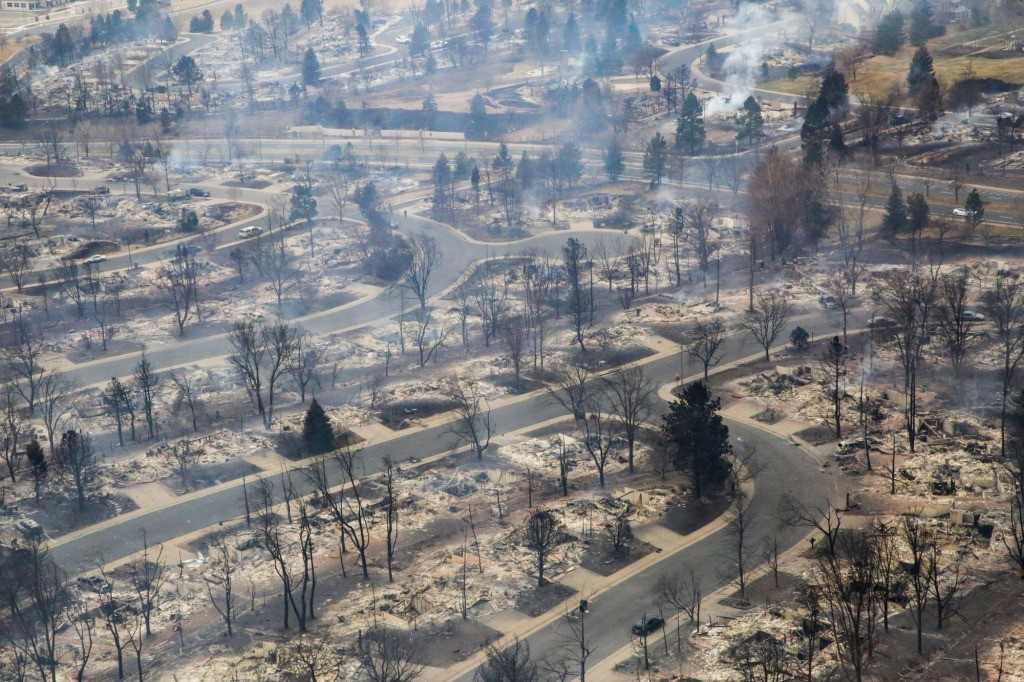Page snapshot: Write the page snapshot here.
Topics covered on this page: Fire inspires action; Cheatgrass and fire; Students acting and learning; The ACT for Climate Toolkit; Resources.
Credits: Funded by the National Science Foundation. Any opinions, findings, and conclusions or recommendations expressed in this material are those of the author(s) and do not necessarily reflect the views of the National Science Foundation. Page by Tiffany Boyd & Don Haas (2023)
Updates: Page last updated September 1, 2023.
Image above: The Marshall Fire destroyed over a thousand homes in December of 2021. Photo credit: The Denver Post.
Fire inspires action
On December 30, 2021 a grass fire began in Boulder County, Colorado. In short order, it grew into the Marshall Fire. The fire killed two people and, in terms of buildings destroyed, the Marshall Fire is the most destructive blaze in Colorado history. An estimated 1084 buildings were destroyed, including over a thousand homes, a hotel and a shopping center.
Since the fire, the county has been exploring its management of open spaces and grassland that surround our communities. Four of the top five largest wildfires on record in Colorado occurred between 2018 and 2021.

On December 30, 2021, hurricane force winds with gusts to 115 mph roared down the front slope of the Rocky Mountains. The winds fueled grass and brush fires that pushed into the towns of Superior and Louisville. The Marshall Fire killed two and destroyed over a thousand homes. Photo from NASA’s Earth Observatory, Public Domain.

Another view of the Marshall Fire. People had known fire was a threat to mountain communities. The Marshall Fire highlighted how fire also threatens communities along the Front Range Grassland Corridor. (Photo credit: Jack from Boulder, Colorado, U.S. Wikimedia Commons, Creative Commons Attribution-ShareAlike Unported license)
Cheatgrass and fire
The fire had two different ignition sources and was quickly out of control due to high winds of over 100 mph and extremely dry high grasses. A very wet spring, followed by a dry dry summer and fall, made the grasses, specifically cheatgrass, very tall and very dry.
The fire inspired communities to change building codes and address grassland management more thoughtfully. See the extensive StoryMap, Grassland Management in Boulder County produced by The Watershed Center in collaboration with the Boulder County Fireshed Grasslands Working Group for a deep description of this work.

Resilient Landscapes and Fire Adapted Communities goals as defined by the Wildland Fire Leadership Council (2023). Opportunities for student engagement can be found for any and all of the goals. See also Grassland Management in Boulder County.
Students acting and learning
Initiatives inspired by the fire included Classrooms for Climate Action (C4CA) working with fifth grade students from the community to both pull cheatgrass and learn about relationships among grasslands, invasive grasses, and fire ecology. A key piece of this is students taking action to reduce climate related risks in the community and learning about why these actions reduce risks.
When C4CA contacted the City of Louisville Open Space department, they told us that they frequently use volunteers to mitigate and pull cheatgrass and other invasive species growing in our open space lands around Louisville. They were thrilled with the idea of teaching the students about this, and getting them involved in this climate action.
Catherine Jepson, Open Space Specialist for the City of Louisville said, “The City of Louisville Open Space takes measures annually to mitigate the impact of cheat grass, a highly competitive non-native grass species that can pose significant challenges in natural environments. Collaborative efforts with the Louisville Elementary School classes to control cheat grass on Daughenbaugh Open Space not only helped preserve the local ecosystem but also reduces the risk of wildfire. By working together, the City of Louisville and local schools can make a significant difference in managing this invasive species and reducing the risk of wildfires in the area.”

Fifth grade students remove cheatgrass from local open space land in Louisville, CO. (Photo used by permission, Tiffany Boyd, C4CA)
The ACT for Climate Toolkit
Since the fire, the City of Louisville, surrounding municipalities, and Boulder County have been increasing their use of rotational grazing and other fire mitigation strategies to improve water retention in the soil, soil health, and manage the height of the grasses.
The collaborative work of C4CA, the City of Louisville, and the students is an example of the application of the ACT for Climate Toolkit. (Boyd et al, 2023). The framework can be used to inform the design of instruction that incorporates climate action for a wide range of climate issues.

The ACT for Climate Toolkit. Credit: University of Colorado Boulder School of Education, Classrooms for Climate Action, and the University of California Museum of Paleontology at Berkeley’s Understanding Global Change Project.
This ACT for Climate Toolkit is a framework for planning climate action units that can be integrated into any discipline. In Louisville, Colorado, the fifth graders were studying ecosystem restoration and the Toolkit helped in planning a unit which integrated the local climate phenomena of drought and invasive grasses into their existing unit. Six months earlier, a fire which caused 40,000 people to evacuate, had come within blocks of their school. Fire carried by high winds ignited the dry cheatgrass throughout the area and burned 1,000 homes. Students learned about the emergency preparedness efforts of the county and the lessons learned from the Marshall Fire. Upon examining issues of climate justice in the local area, emergency preparedness for the Marshall Fire revealed several lessons to be learned in preparation of future climate events. Also, students partnered with the City of Louisville Open Space management to examine the data around cheatgrass spread. Additionally, students learned about indigenous perspectives on cultural and prescribed burns that had been guiding forest management for generations. Students walked to nearby open space properties near their school and were trained on how to remove cheatgrass in a way that doesn’t spread its seeds. Understanding the conditions which led to the fire, and giving students a direct way to participate in climate action made this ecosystem restoration unit relevant to the local community.
When teachers and kids have an opportunity to participate in local climate action, we raise the engagement of their families and the entire community. Assisting our schools and communities in acknowledging the realities of drought in the west, the need to address the growing issue of invasive species, and identifying fire mitigation strategies empowers entire communities to take needed climate action. Students are the catalyst for change. Valuing their skills and contribution to local climate solutions supports student agency and hope as the next generation navigates their life long relationship with climate change.
Resources
Web resources
Grassland Management in Boulder County is an ESRI StoryMap produced by The Watershed Center in collaboration with the Boulder County Fireshed Grasslands Working Group. StoryMaps are interactive maps designed to tell specific stories.
-
The Watershed Center in collaboration with the Boulder County Fireshed Grasslands Working Group. “Grassland Management in Boulder County.” ArcGIS StoryMaps, August 11, 2023. https://storymaps.arcgis.com/stories/62435c5cd6554d4d8143dd0c967fc2d3.
Understanding Global Change is a guide to how human action and non-human processes interact to change the Earth’s environment and its habitability. This site is a project of the University of California Museum of Paleontology (UCMP).
-
Marshall, Charles, Jessica Bean, Helina Chin, Trish Roque, Lucy Chang, Josh Frankel, Anna Thanukos, and Lisa White. “Understanding Global Change.” Understanding Global Change. Accessed September 1, 2023. https://ugc.berkeley.edu/.
Scientific articles & abstracts
- Boyd, Tiffany, Jessica Bean, and Melissa Braaten. “Integrating Climate Action Across the K-5 Curriculum: Climate Science, Climate Justice, and Climate Solutions.” San Francisco, CA: The American Geophysical Union, 2023.



